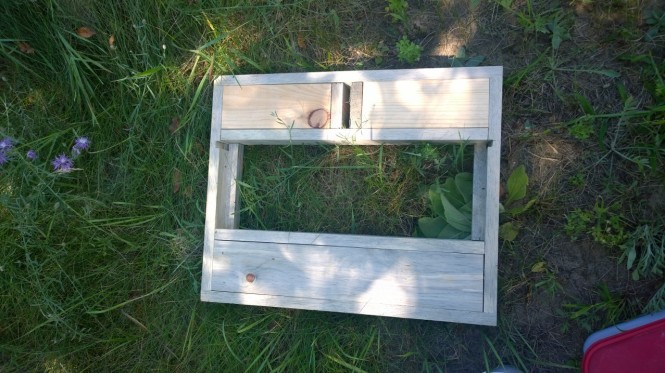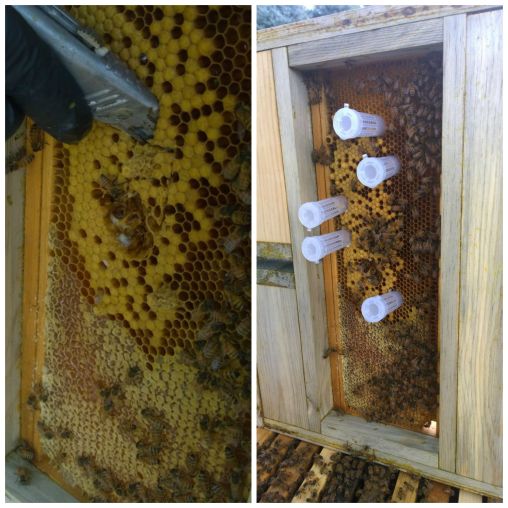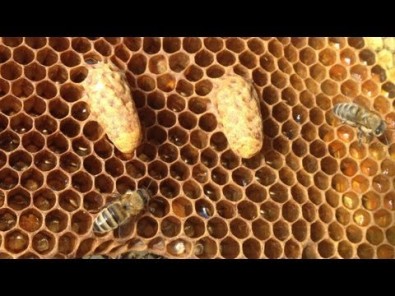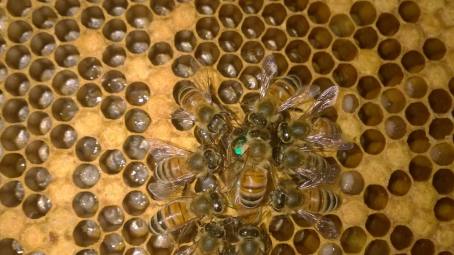Man, oh man, things have been busy on the homestead. I’ve been up to my eyeballs in peaches, cucumbers, and tomatoes that need canning. We also picked a wheelbarrow full of apples to start our first batch of hard cider. We’ve taken turkeys to butcher, cut back some of the garden… it’s starting to feel like fall is coming. It’s pretty much been business-as-usual in the beeyard, however, but I wanted to share this queen-rearing technique that we’ve been playing around with.
First of all, it seems to me that everyone panics when their queen dies or isn’t laying. Certianly, if your hive is missing a queen and there are no eggs laid, you’re in a bit of a bind, but if you have eggs, the bees will make a queen. This summer we’ve been watching the hives weekly and really learning a lot about the business of raising queens.
As you may rememember, we installed four packages in the spring and two of the packages drifted into the third almost immediately after intallation. It resulted in what we call Mega Hive. We ended up splitting Mega Hive several times this summer, but also watched it like a hawk for swarming. We noticed that they built a lot of queen cups in that hive and then they started actually growing queens in the upper boxes. The queen was still alive and well and laying the most beautiful brood pattern in the brood boxes, so we decided to experiment and cut the queen cells out. We experimented with them by putting them in queen-less splits, or keeping them in queen cages to hatch. Pretty much all of them hatched. A few in the queen-less hives hatched, then the bees killed her, then raised their own. So it’s been an interesting summer, in that regard.
My husband even built this adorable tiny hive with tiny little frames and we’ve been using that has a holding tank for extra queens (one at a time, of course) with a few workers thrown in.
About two months ago my husband found a free ebook called I.M.N. System Of Queen Rearing by Mel Disselkoen. This is a variation of The Hopkins Method of Queen-Rearing. We thought this method was interesting, so we decided to give it a try.
In order for this to work, you have to use a hive that does not have a queen and you have to remove any eggs that are in there (and save one frame for the process outlined below). If you don’t, the bees will just build comb on the horizontal frame (see below) and raise their own queen from one of the eggs (we speak from experience).
So the first thing to do is fashion a cover that will allow you to install a frame horizontally in the hive:
In order to do this, you need to use a frame of eggs in comb that is not built off of plasticell. The reason for this (as we learned the hard way) is that it is easier to cut the queen cells off when you aren’t trying to saw through plasticell. The next thing you want to do is plug the same number of cells as you’d like queens (we went for 14 on attempt #1). My husband made bullet-shaped “plugs” out of wooden dowels, but anything that’s the right size will work (q-tips are another option):
Then you sprinkle the entire frame with flour. It needs to be heavily coated. (The photo below was taken mid-sprinkle). The reason you’re doing this is to kill all of the eggs except the ones you want turned into queens.
Shake off the excess flour, then remove the plugs, place the cover on, comb-side down, and go about your business.
12 days later, we came back to check our progress and found 10 queens! They are kind of in the frame all over the place (probably because we didn’t do an amazing job of flour-sprinkling), but they are there!
Now, getting them out was a bit tricky because the comb was built on plasticell (live and learn). First we tried cutting them out with a knife, but that was a mess, so then we used queen cups to kind of cut out circles around each one and then scoop each one out. We did squish a few in the process, but overall it was pretty much a success.
So it wasn’t perfect and we lost a few, but it was seriously pretty darn easy. One thing that frustrates me whenever we go to beekeeping workshops and conferences is that it seems like many treat queen-rearing like some advanced skill that newbies better not try and do. Maybe because the people running the sessions sell queens too and your ignorance is their gain! You do need to know that it takes 16 days for a queen cell to hatch and, as a result, you really need to keep an eye on things, otherwise she’ll hatch before you have a chance to move the cell!
If nothing else, one thing we learned is that you might as well try! You never know what you might learn, and if you accidentally squish one, then cut it open and have a mini-dissection! Might as well make it a worthwhile death.
Other Resources to Check Out:












